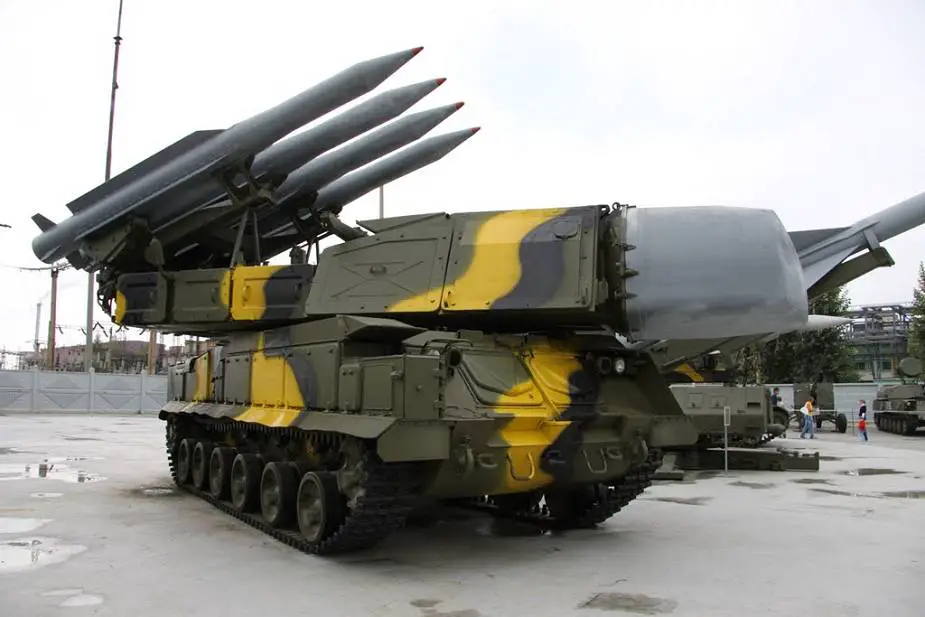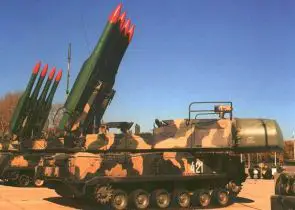- Army
- Air Defense Systems
- Anti-tank systems and vehicles
- Armored Vehicles
- Armoured personnel carriers
- Artillery Vehicles and Weapons
- Command Post
- Communication Vehicles and Systems
- Electronic Warfare
- Engineer | Maintenance Vehicles
- Infantry Fighting Vehicles
- Main Battle Tanks
- Missiles
- Tactical and Logistic Vehicles
- Radars
- Unmanned Systems
- Weapons
- Navy
- Air
SA-11 Gadfly Buk-M1 9K37
BUK-M1 SA-11 Gadfly 9K37
Surface-to-air defense missile system - Russia

Description
The BUK-M1 (NATO code: SA-11 Gadfly) missile system is a self-propelled, medium-range surface-to-air missile system developed by the Russian defense industry. The SA-11 Gadfly is intended to defeat tactical and strategic aircraft, cruise missiles, helicopters and other aerodynamic targets throughout the entire range of their combat employment in severe ECM environments, as well as Lance-type tactical ballistic missile, HARM-type antiradar missiles and other airborne and ground-based high precision weapons and to engage waterborne and radio-contrast ground targets. The first version of BUK-M1 adopted into service carried the GRAU designation 9K37 and was identified in the west with the NATO reporting name "SA-11 Gadfly". Since its initial introduction into service, the BUK-M1 missile system has been continually upgraded and refined with the latest incarnation carrying the designation 9K37M2 "BUK-M2". SA-11 Gadfly battery requires 5 minutes to set up before it is ready for engagement and can be ready for transit again in 5 minutes. The reaction time of the battery from target tracking to missile launch is around 22 seconds
Buk-M variants:
- BUK-M2: modernized version of BUK-M1
- Buk-M1-2 9K37M1-2: For the export market, which is an improved variant of the 9K37M1 Buk-M1.
Technical Data
| Armament |
|
The SA-11 Gadfly is essentially a tracked chassis that carries a radar and a launcher with four missiles. The arrangement of the radar and the missile launcher on one rigid platform allows their simultaneous laying in azimuth and elevation with the aid of an electrohydraulic drive. The radar fitted to each SA-11 Gadfly is referred to as the 'Fire Dome' by NATO, it is a monopulse type radar and can begin tracking at the missile's maximum range (32 km/20 mi) and can track aircraft flying at between 15,000 and 22,000 m (50,000 to 72,000 ft) altitudes. It can guide up to three missiles against a single target.
|
| Missile |
|
The SA-11 Gadfly can fire 9M38 and 9M38M1 missiles. The 9M38 missile uses a single-stage X-winged design without any detachable parts. The design had to conform to strict naval dimension limitations, allowing the missile to be adapted for the M-22 SAM system in the Soviet Navy. Each missile is 5.55 m long, weighs 690 kg, and carries a relatively large 70 kg warhead which is triggered by a radar proximity fuze. In the forward compartment of the missile a semi-active homing radar head, autopilot equipment, a power source and a warhead is located.
|
| Mobility |
| The Buk-M1 uses the GM-569 chassis designed and produced by JSC Metrowagonmash. The crew compartment provides protection from small arms fire as well as being sealed against NBC attacks. The suspension on either side consists of six dual roadwheels with the drive sprocket at the rear, idler at the front, and four track-return rollers which support the inside of the double-pin track only. The 9K37 SA-11 Gadfly can run at a maximum speed of 65 km/h on a road and 45 km/h on cross-country, with a maximum range of 500 km. |
| Command and control vehicles |
| A standard Buk battalion consists of a command vehicle, target acquisition radar (TAR), six transporter erector launcher and radar (TELAR) and three transporter erector launcher reload. A Buk missile battery consists of two TELAR and TEL vehicles. The 9K37 SA-11 Gadfly utilizes the 9S18 "Tube Arm" or 9S18M1 (NATO name "Snow Drift") target acquisition radar in combination with the 9S35 or 9S35M1 "Fire Dome" H/I band tracking and engagement radar which is mounted on each TELAR. The Snow Drift target acquisition radar has a maximum detection range of 85 km and can detect an aircraft flying at 100 m from 35 km away and even lower flying targets at ranges of around 10–20 km. Snow Drift is mounted on a chassis similar to that of the TELAR, as is the command vehicle. The control post which coordinates communications between the surveillance radar(s) and the launchers is able to communicate with up to six TELs at once. The reloading vehicle 9A39M1 for the Buk battery resembles the 9K37 SA-11 Gadfly but instead of radar, they have a crane for loading missiles. They are capable of launching missiles directly but require the cooperation of a Fire Dome-equipped TELAR for missile guidance. A reload vehicle can transfer its missiles to a TELAR in around 13 minutes and can reload itself from stores in around 15 minutes. |
Specifications
| Armament | Missile altitude |
| 4 missiles 9M38 / 9M38M1 | 20 to 22,000 m |
| Country users | Engagement range |
| Belarus, Finland, Russia, Syria, Ukraine, and Serbia. | 32 to 35,000 m maximum |
| Missile weight | Warhead |
| 685 kg | 70 kg HE High Explosive fragmentation |
| Missile speed | Radar |
| 850 m/s | Flat Box-B |
| Crew | Dimensions vehicle |
| 3 | Length: 9.96 m; Width: .31 m; Height: 3.8 m |
Details View
 |
|
 |
 |
 |
 |
Pictures - Video



























